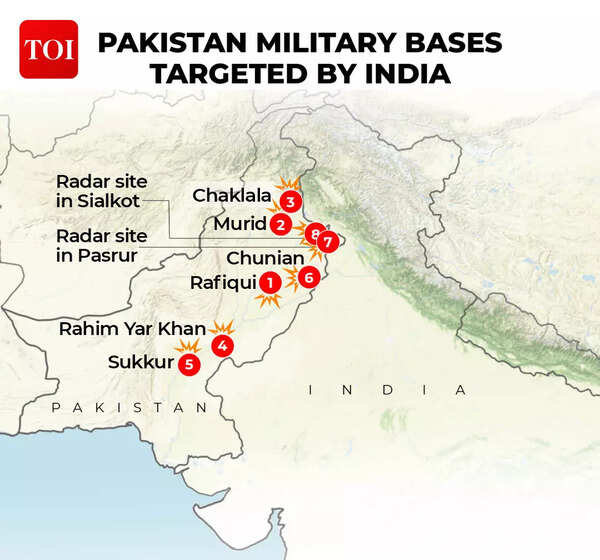- News
- India News
- Pakistan's 11 air bases, 9 terror camps: What did India achieve with Operation Sindoor?
Trending
Pakistan's 11 air bases, 9 terror camps: What did India achieve with Operation Sindoor?
India launched Operation Sindoor, a decisive strike against terror camps in Pakistan and PoJK, targeting groups like Lashkar-e-Taiba. The operation demonstrated India's capability to strike deep within Pakistan, challenging established boundaries and exposing vulnerabilities in Pakistan's air defence.
NEW DELHI: The Indian military reported on Sunday that it inflicted significant damage on Pakistan's military forces during a three-day confrontation, including downing fighter jets with advanced technology and striking military installations near Islamabad.Director general of military operations Lt Gen Rajiv Ghai stated that 35-40 Pakistani military personnel were killed in the combat operations. "Pakistan will have to pay a very heavy price if it resorts to any more misadventure," said Lt Gen Ghai, adding that India had achieved its desired objectives.The damage inflicted included the destruction of Pakistani fighter jets equipped with latest technologies and strikes on key military facilities near Pakistan's capital. India executed a significant military operation within Pakistan and Pakistan-occupied Kashmir (PoK) in response to civilian casualties. The operation accomplished numerous strategic objectives.
Poll
Should India continue to conduct operations deep within enemy territory?

Strikes deep within Pakistan territory
India demonstrated a significant shift in its military strategy by showing readiness to conduct strikes deep within Pakistan's territory, including sensitive areas like Punjab province and Bahawalpur, moving beyond the traditional engagement limited to PoK.India's strikes reached hundreds of kilometers inside Pakistan, including areas like Bahawalpur that even the United States had not targeted with drone operations. The operations extended to Punjab province, which is considered a strategic military stronghold of Pakistan.Through these actions, India has established that it can reach any location within Pakistan, making it clear that neither the Line of Control nor Pakistan's internal territories are exempt from potential strikes.Terrorists and their backers the same: New paradigmThe new approach targets both terrorists and their supporters, marking a departure from previous policies that treated them separately. The operation established a clear stance against terrorism, implementing a doctrine of calibrated deterrence. It eliminated the traditional separation between terrorist organisations and their supporters. It also undermined the long-standing assumption that certain influential rogue elements within the Pakistani state could orchestrate terrorist activities with impunity. Jamming Pakistan’s air defence gridIndian forces conducted successful strikes using Rafale jets equipped with SCALP missiles and HAMMER bombs, effectively bypassing or jamming Pakistan's air defence systems during a precise 23-minute operation.The rapid operation revealed vulnerabilities in Pakistan's air defence infrastructure, as Indian forces were able to penetrate their systems without any reported losses.The mission's success demonstrated India's technological and strategic capabilities in executing precise military operations.Defence infrastructure impactIndia has demonstrated significant advances in modern air defence capabilities through its integrated defense systems and successful penetration of Chinese-made systems used by Pakistan. The Akashteer Air Defence System emerged as a particularly successful component, having neutralized hundreds of Pakistani drones and missiles. Its proven performance positioned it as a potential export option in the global defense market.Damage to Pakistan’s militaryThe strikes affected 11 Pakistani air bases, including Nur Khan, Rafiqui, Murid, Sukkur, Sialkot, Pasrur, Chunian, Sargodha, Skaru, Bholari and Jacobabad, significantly impacting their air force infrastructure. This led to destruction of 20% infrastructure of Pakistan’s airforce. India bombed Pakistan’s Bholari Air Base killing over 50 people including Pakistan’s squadron leader Usman Yousuf, 4 airmen among others as well as destroying Pakistan’s fighter jets.Joint warfare capabilityThe Army, Navy, and Air Force came together to execute coordinated strikes, prooving India’s growing joint warfare capability. The operation showcased India's tri-service coordination and precision targeting capabilities, avoiding civilian casualties while achieving military objectives.End of Article
Follow Us On Social Media










